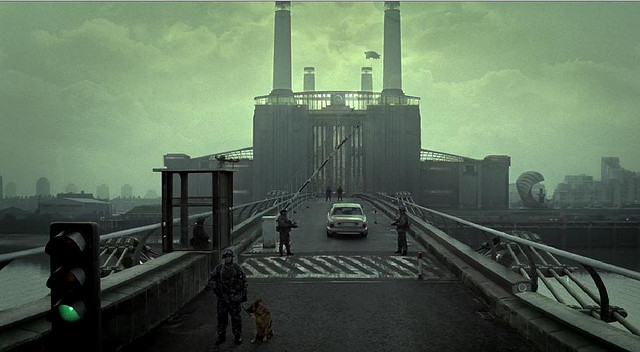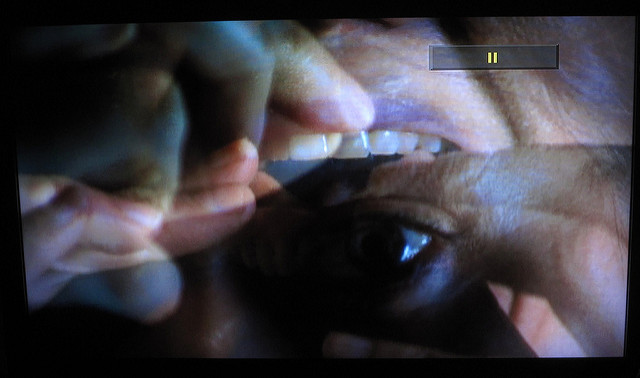Alfonso Cuarón is one of Hollywood’s most important filmmakers. With the release of Gravity, it’s not hard to understand why. Cuarón’s direction, and Emmanuel Lubezki‘s cinematography, are stunning. Indeed, Gravity is as much its own cultural moment as Cuarón’s past features, including Y Tu Mamá También, and Children of Men.
I’ve been drawn to Cuarón’s work not only because of his technical accomplishments, but also out of appreciation for the recurring theme of reincarnation in these three films. The Mexican director approaches personal and social transformation, via the theme of rebirth, in a manner that elevates his features into explorations of how to bear the endless brutality that marks periods of extended crisis and social change.
This is likely a perspective born in his country of birth, as is made clear in Y Tu Mamá También. The 2001 drama caused a stir upon its release because of its explicit sexual content. Look past the sex scenes though, beneath the covers, to speak, and you’ll find a lot more topics being tackled. As it should be. Since when is sex just about nooky?
Cuarón puts a new spin on an old story: two teenagers take a road trip. Their goal is to get it on with an older woman. Along the way, we get a bird’s eye view of the social and economic upheaval Mexico was undergoing in 1999. Following a period of privatization, the country was also facing the end of the Institutional Revolutionary Party‘s 71-year hold on the presidency, and the emergence of a new opposition led by businessman Vicente Fox.
También draws dramatic parallels between sex and hopelessness. Rather than marking a journey into maturity, sex becomes a strategy for the three protagonists to avoid confronting pressing issues in their own lives. Tellingly, they embark on a paradisiacal journey to a lovers’ point with a hazy location known as “Heaven’s Mouth.” It’s a climax, for sure – but one of compensatory denial, where pleasure and ideology are fused, as though in a moment of orgasm.
Children of Men has numerous scenes featuring characters espousing superstition, engaging in drug use, resorting to electronic stimulation, even the purposeless accumulation of artwork, for similar purposes. The alternative would mean facing the reality of fascist Britain: the human race has gone sterile and, facing its extinction, has politically regressed. Gravity relies on a simpler narrative. Its protagonist, Dr. Ryan Stone (Sandra Bullock), considers suicide, as the world around her descends into chaos. Cuarón fans are reminded of Children of Men‘s War on Terror-chic suicide kits.
In También, that possibility wins the day. The lovers’ trip turns out to be a nightmare leading to death and bitterness. For Cuarón, this is a way of telling the story of Fox’s ascent to Mexico’s presidency, and the ensuing bloodbath of his rule. Rather than using the uncertainty of their lives to imagine new possibilities, the trio thus fall back on their own worst personal qualities, inevitably leading to tragedy. The personal is again the political. También is about a rebirth that never was, both for its protagonists, and Mexico.
This regression also frames the British political landscape of Children of Men, which is transformed by a sudden confluence of crises into a fascist state with a terrorist opposition. Humanity’s sterility is key. The lack of revolutionary horizon this suggests – history really is over – helps underline the appeal of fascism. Nihilism is the only alternative.
The first known pregnant woman in a generation, Kee (Clare-Hope Ashitey,) reveals herself to the protagonist Theo Faron (Clive Owen) in a barn. The messianic illusions of the affair become all too real. Their baby is the perfect object onto which the film’s characters project a practically Biblical ideal of emancipation, and of humanity renewing itself.
Slavoj Zizek has praised Children of Men for linking the child’s quasi-religious birth to a desperate need for revolution, particularly in the violence of its final scenes. We end the film by watching Faron, the child, and Kee use a rowboat to suspend themselves from the unbearable monstrosity that is Britain gone awry, and await a mythical ship called The Tomorrow to retrieve them from the mist.
Rather than regress, the characters remain committed to progress. When the ship is about to retrieve them, we’re left with the impression that something new is about to begin. It’s a fitting end, considering the director’s intense preoccupation with resignation. This is a unique twist, not just in comparison to his previous work, but politically, too.
Which brings us to Gravity. Although the plot seems more-or-less secondary to the visuals, the same themes hold true. In typical Cuarón fashion, after an orbital disaster, Dr. Stone’s inability to navigate her immediate surroundings is a consequence of her inability to process her daughter dying.
The physician’s feeling of powerlessness is set against the backdrop of an orbiting mass of high-velocity space junk ripping both humans and technology to shreds, without exception. Again, it’s an old story, set in a new context. In this instance, it’s a science fiction recasting of nature’s obliviousness to individual suffering. There is a Job-like quality to the story, again, replete with obvious religious motifs.

It’s only through facing up to the sheer randomness of death that Dr. Stone begins to undergo a personal transformation. Visually, this is mostly indicated through parallels with the birthing process. These include the physician being tied to another astronaut by a tether (an umbilical cord) and clearly being in a fetal position, when she is finally able to breathe oxygen again in an airlock.
When the hopelessness of the void presses her to consider suicide, Dr. Stone hallucinates and begins to cling to life anew. This scene works precisely because of the randomness of how she suddenly has this epiphany, for no other reason than she needs it. The film’s tagline “Don’t Let Go,” is tied to this idea, which is almost mystical in that it is based in moments when human beings don’t have a rational explanation for why they move forward in a better way. They just do it.
Dr. Stone develops an uneasy enthusiasm to live for another day. Her atmospheric re-entry conjures up ideas of renewal, and reincarnation more specifically. At one point it looks like an embryo. At another, its burning wreckage is made to look like semen. Dr. Stone eventually washes up on a beach, taking her second “first steps” as her legs adjust to the Earth’s gravity. Think the conclusion of Y Tu Mama, but in reverse. This really is Heaven’s Mouth.
Certainly, one might argue that I’m attributing too much to the director. But that would be to miss their point. It’s important to pay attention to the politics of Cuarón’s films, I think, because in pursuing the same thematic elements, they document the various different ways that people respond to crisis, in the absence of viable opposition. It’s very post-Cold War, in that respect. Without actually existing political alternatives to the market, we must still have hope.
One might think that it’s just about Mexico. That the director has to be geographically confined. My response would be that viewers need to see the Central American state as something of a laboratory. Not just for experiments in framing hopelessness. But, as I imagine, clinging to the notion of survival, wherever. Reincarnation, or so Cuarón suggests, is universal.
Photographs courtesy of sparkynufc_86, MoviesInLA, and Gage Skidmore. Published under a Creative Commons License.






